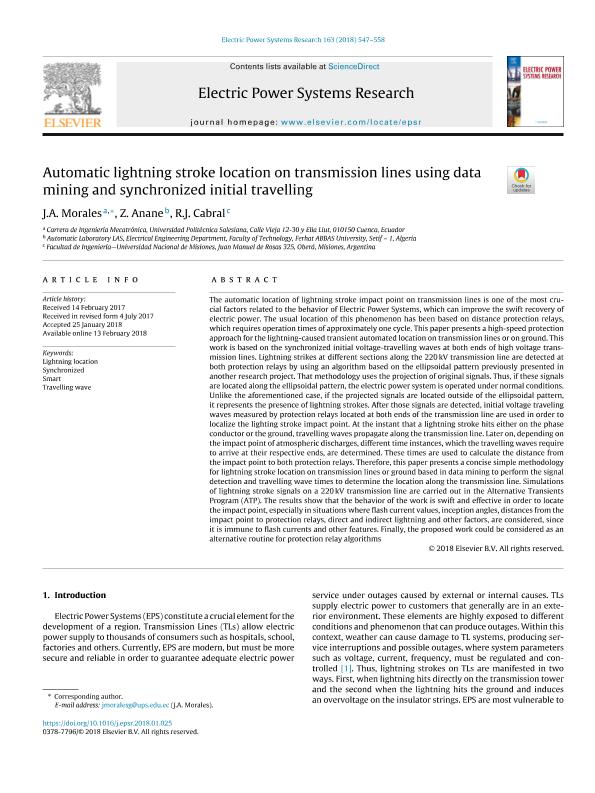Mostrar el registro sencillo del ítem
dc.contributor.author
Morales Garcia, John Armando

dc.contributor.author
Anane, Z.
dc.contributor.author
Cabral, Roberto José

dc.date.available
2021-02-04T20:43:30Z
dc.date.issued
2018-10
dc.identifier.citation
Morales Garcia, John Armando; Anane, Z.; Cabral, Roberto José; Automatic lightning stroke location on transmission lines using data mining and synchronized initial travelling; Elsevier Science SA; Electric Power Systems Research; 163; 10-2018; 547-558
dc.identifier.issn
0378-7796
dc.identifier.uri
http://hdl.handle.net/11336/124882
dc.description.abstract
The automatic location of lightning stroke impact point on transmission lines is one of the most crucial factors related to the behavior of Electric Power Systems, which can improve the swift recovery of electric power. The usual location of this phenomenon has been based on distance protection relays, which requires operation times of approximately one cycle. This paper presents a high-speed protection approach for the lightning-caused transient automated location on transmission lines or on ground. This work is based on the synchronized initial voltage-travelling waves at both ends of high voltage transmission lines. Lightning strikes at different sections along the 220 kV transmission line are detected at both protection relays by using an algorithm based on the ellipsoidal pattern previously presented in another research project. That methodology uses the projection of original signals. Thus, if these signals are located along the ellipsoidal pattern, the electric power system is operated under normal conditions. Unlike the aforementioned case, if the projected signals are located outside of the ellipsoidal pattern, it represents the presence of lightning strokes. After those signals are detected, initial voltage traveling waves measured by protection relays located at both ends of the transmission line are used in order to localize the lighting stroke impact point. At the instant that a lightning stroke hits either on the phase conductor or the ground, travelling waves propagate along the transmission line. Later on, depending on the impact point of atmospheric discharges, different time instances, which the travelling waves require to arrive at their respective ends, are determined. These times are used to calculate the distance from the impact point to both protection relays. Therefore, this paper presents a concise simple methodology for lightning stroke location on transmission lines or ground based in data mining to perform the signal detection and travelling wave times to determine the location along the transmission line. Simulations of lightning stroke signals on a 220 kV transmission line are carried out in the Alternative Transients Program (ATP). The results show that the behavior of the work is swift and effective in order to locate the impact point, especially in situations where flash current values, inception angles, distances from the impact point to protection relays, direct and indirect lightning and other factors, are considered, since it is immune to flash currents and other features. Finally, the proposed work could be considered as an alternative routine for protection relay algorithms
dc.format
application/pdf
dc.language.iso
eng
dc.publisher
Elsevier Science SA

dc.rights
info:eu-repo/semantics/openAccess
dc.rights.uri
https://creativecommons.org/licenses/by-nc-sa/2.5/ar/
dc.subject
LIGHTNING LOCATION
dc.subject
SMART
dc.subject
SYNCHRONIZED
dc.subject
TRAVELLING WAVE
dc.subject.classification
Ingeniería Eléctrica y Electrónica

dc.subject.classification
Ingeniería Eléctrica, Ingeniería Electrónica e Ingeniería de la Información

dc.subject.classification
INGENIERÍAS Y TECNOLOGÍAS

dc.title
Automatic lightning stroke location on transmission lines using data mining and synchronized initial travelling
dc.type
info:eu-repo/semantics/article
dc.type
info:ar-repo/semantics/artículo
dc.type
info:eu-repo/semantics/publishedVersion
dc.date.updated
2020-12-11T14:57:37Z
dc.journal.volume
163
dc.journal.pagination
547-558
dc.journal.pais
Países Bajos

dc.journal.ciudad
Amsterdam
dc.description.fil
Fil: Morales Garcia, John Armando. Universidad Politecnica Salesiana; Ecuador. Consejo Nacional de Investigaciones Científicas y Técnicas; Argentina
dc.description.fil
Fil: Anane, Z.. Ferhat ABBAS University; Argelia
dc.description.fil
Fil: Cabral, Roberto José. Universidad Nacional de Misiones. Facultad de Ingeniería; Argentina
dc.journal.title
Electric Power Systems Research

dc.relation.alternativeid
info:eu-repo/semantics/altIdentifier/doi/http://dx.doi.org/10.1016/j.epsr.2018.01.025
dc.relation.alternativeid
info:eu-repo/semantics/altIdentifier/url/https://www.sciencedirect.com/science/article/abs/pii/S0378779618300336
Archivos asociados
